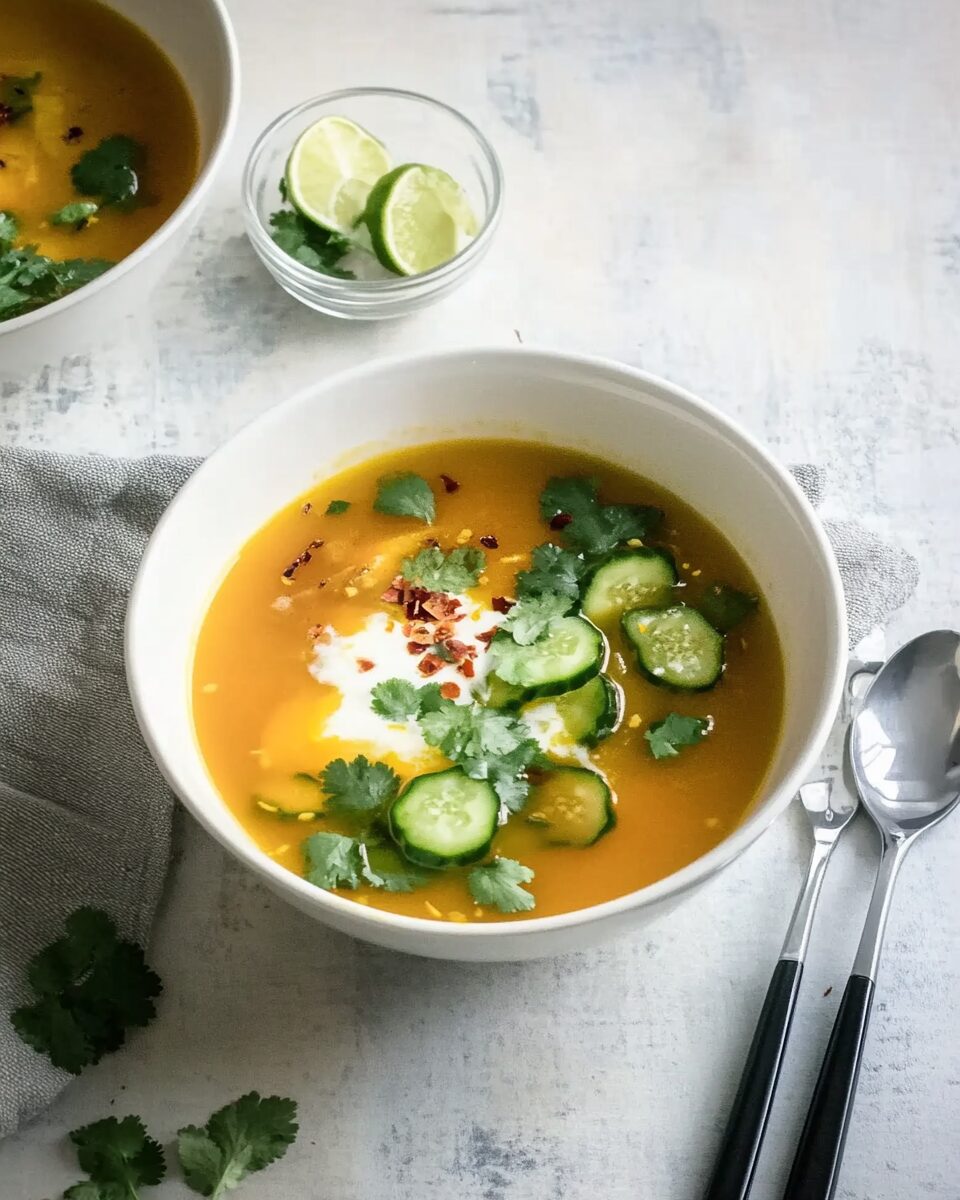This Vietnamese Kabocha Squash Soup is a hearty and flavorful dish that blends the rich sweetness of kabocha squash with the fragrant spices of Vietnamese cuisine. It’s a great soup for colder months, offering a comforting and aromatic experience. The smooth texture of the squash pairs perfectly with the savory broth, making it a perfect meal for any occasion.
Full Recipe:
Ingredients
- 1 medium kabocha squash (about 3 pounds), peeled and cut into chunks
- 1 tablespoon vegetable oil
- 1 medium onion, diced
- 3 cloves garlic, minced
- 1-inch piece of ginger, minced
- 4 cups vegetable broth
- 1/4 cup coconut milk
- 2 tablespoons fish sauce
- 1 tablespoon soy sauce
- 1 tablespoon sugar
- 1 teaspoon ground turmeric
- 1/2 teaspoon ground cinnamon
- Salt and pepper to taste
- Fresh cilantro for garnish
- Sliced chili (optional for garnish)
Directions
- Heat the vegetable oil in a large pot over medium heat. Add the onion, garlic, and ginger, and sauté until fragrant, about 3 minutes.
- Add the kabocha squash chunks and stir to combine. Cook for another 5 minutes.
- Pour in the vegetable broth, coconut milk, fish sauce, soy sauce, and sugar. Stir in the ground turmeric, ground cinnamon, salt, and pepper. Bring the soup to a boil, then reduce the heat and simmer for 20-25 minutes, or until the squash is soft.
- Use an immersion blender to purée the soup until smooth. If you don’t have an immersion blender, you can transfer the soup in batches to a regular blender.
- Taste and adjust seasoning if needed.
- Serve hot, garnished with fresh cilantro and sliced chili if desired.
Nutrients
- Calories: 180
- Protein: 3g
- Carbohydrates: 36g
- Fat: 4g
- Fiber: 6g
- Sugar: 10g
- Sodium: 600mg
- Vitamin A: 10% of daily value
- Vitamin C: 20% of daily value
Health Benefits
Kabocha squash is not only delicious but also packed with nutrients. It is rich in vitamins A and C, antioxidants that support immune function and skin health. The squash also provides dietary fiber, promoting digestive health, and essential minerals like potassium and magnesium, which are vital for heart and muscle function. When combined with lean proteins such as pork or shrimp, the soup becomes a balanced meal, offering a good mix of carbohydrates, proteins, and healthy fats.
Additionally, the ingredients in the soup, such as fresh herbs and spices, can have therapeutic benefits. Garlic and ginger, commonly used in Vietnamese cuisine, are known for their anti-inflammatory properties and help in boosting the immune system. Ginger aids digestion, while garlic may help lower blood pressure and cholesterol. Together, these ingredients create not only a flavorful but also a health-boosting dish.
Traditionally, this soup is enjoyed as part of a family meal, often accompanied by steamed rice and other side dishes. Its simplicity and the use of readily available ingredients make it a popular choice in Vietnamese cuisine. The versatility of the soup allows it to be adapted with various proteins or seasonings, making it both a comforting dish and a canvas for different regional tastes. The dish, with its origins in the north of Vietnam, often relies on simple yet flavorful broths that complement the natural sweetness of the squash.
Variations Across Regions
Vietnamese Kabocha Squash Soup showcases regional diversity, with variations in ingredients and preparation methods. In central Vietnam, the soup might be spiced with local chilies and herbs, adding a distinct heat and flavor. Southern versions often include a sweeter broth and are garnished with fresh herbs like saw-tooth leaves, enhancing the aroma and taste. Some regions prefer a clear broth, while others opt for a richer, milky consistency achieved by adding coconut milk or ground rice.
The use of different meats and seafoods also varies by region. In the north, pork is commonly used, while in the south, shrimp or fish might be added for a lighter, more delicate flavor. In some versions, the kabocha squash is blended into a smooth, creamy texture, while in others, it remains in chunks to provide a hearty, rustic feel. Each variation tells a story of the region’s local produce, flavors, and culinary history.
Pairing and Serving Suggestions
This versatile soup pairs well with various side dishes. Steamed rice is a common accompaniment, allowing diners to savor the flavorful broth. For a more substantial meal, fried tofu, grilled meats, or a simple Vietnamese omelet can be served alongside. A plate of fresh vegetables or a light salad can provide a refreshing contrast to the warmth of the soup.
In addition to the typical sides, Vietnamese Kabocha Squash Soup can be served with various dipping sauces or condiments. A traditional Vietnamese chili sauce or fish sauce on the side can add an extra layer of flavor and spice. A few sprigs of cilantro or basil can also be added just before serving, offering a burst of freshness that enhances the soup’s savory richness.
A Comforting Dish for All Seasons
Despite being particularly popular in the colder months, Vietnamese Kabocha Squash Soup is suitable for enjoyment year-round. The natural sweetness of the kabocha squash combined with the savory broth offers warmth and nourishment no matter the season. Its ability to satisfy and comfort, while also being refreshing with its aromatic herbs, makes it a versatile dish that can be adapted for any occasion.
The soup also holds a special place in Vietnamese festivals and family gatherings. It is often served during Tet, the Vietnamese Lunar New Year, as it symbolizes abundance and the warmth of family. The communal nature of enjoying this soup, often served in large pots for sharing, further solidifies its role in bringing people together, making it more than just a meal but a part of Vietnamese culture and tradition.
Conclusion
Vietnamese Kabocha Squash Soup is more than just a meal; it’s a reflection of Vietnam’s rich culinary heritage and the resourcefulness of its people. As the popularity of Vietnamese cuisine grows globally, dishes like Kabocha Squash Soup represent the ability of traditional recipes to evolve and thrive beyond their cultural origins. It’s a dish that highlights the importance of using fresh, local ingredients, balanced flavors, and the cultural significance of sharing meals with loved ones. The harmonious blend of flavors and textures offers a comforting experience, making it a beloved dish in Vietnamese households and an excellent introduction to the country’s diverse cuisine.






